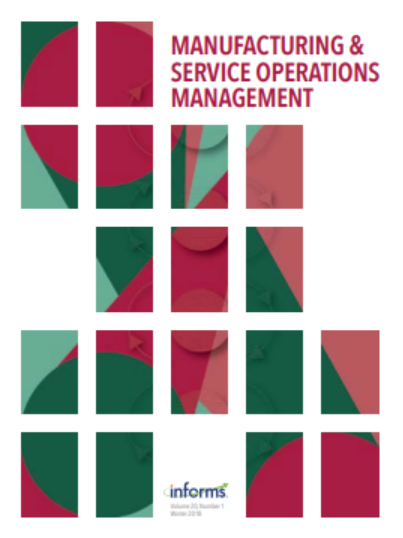了解在线零售环境中履行灵活性的价值
IF 4.8
3区 管理学
Q1 MANAGEMENT
M&som-Manufacturing & Service Operations Management
Pub Date : 2023-03-01
DOI:10.1287/msom.2021.0981
引用次数: 16
摘要
问题定义:配送灵活性,配送中心(dc)满足来自其他dc的需求的能力,可以帮助电子零售商减少销售损失,提高服务质量。由于完全灵活的成本是令人望而却步的,我们试图了解在简单有效的履行政策下部分灵活的履行网络的价值。学术/实践相关性:我们通过数据驱动模型、理论分析和数值模拟,提出了一种理解(部分)履行灵活性的实用价值的一般方法。我们的方法适用于具有本地履行(即,来自原始数据中心的订单履行)优先级和可能的客户放弃的设置,这是履行文献中的两个新特性。然后,我们将此方法应用于大型电子零售商。本文还介绍了一类新的具有理论和实践特点的溢出限制履行政策。方法:我们的分析使用动态和随机优化,应用概率和数值模拟。结果:我们在程式化设置中推导出最优的履行策略,以及使用理论分析在最优策略下的性能界限,为在数值模拟中测试哪些策略提供指导。然后,我们使用模拟来为我们的工业合作伙伴估计,一个具有额外灵活性的拟议履行网络相当于数千万美元的利润改进。管理启示:我们为电子零售商提供了一种方法来了解何时履行灵活性是最有价值的。我们发现,当毛利润相对于履行成本较高或集中库存较低时,履行灵活性为我们的合作者提供了最大的利益。此外,我们以额外的灵活性识别短视履行的风险,并证明有效的溢出限制政策可以减轻这些风险。历史:本文已被接受为2019年制造业&服务营运管理实务研究比赛。补充材料:在线附录可在https://doi.org/10.1287/msom.2021.0981上获得。本文章由计算机程序翻译,如有差异,请以英文原文为准。
Understanding the Value of Fulfillment Flexibility in an Online Retailing Environment
Problem definition: Fulfillment flexibility, the ability of distribution centers (DCs) to fulfill demand originating from other DCs, can help e-retailers reduce lost sales and improve service quality. Because the cost of full flexibility is prohibitive, we seek to understand the value of partially flexible fulfillment networks under simple and effective fulfillment policies. Academic/practical relevance: We propose a general method for understanding the practical value of (partial) fulfillment flexibility using a data-driven model, theoretical analysis, and numerical simulations. Our method applies to settings with local fulfillment (i.e., order fulfillment from the originating DC) prioritization and possible customer abandonment, two features that are new to the fulfillment literature. We then apply this method for a large e-retailer. We also introduce a new class of spillover limit fulfillment policies with attractive theoretical and practical features. Methodology: Our analysis uses dynamic and stochastic optimization, applied probability, and numerical simulations. Results: We derive optimal fulfillment policies in stylized settings, as well as bounds on the performance under an optimal policy using theoretical analysis, to provide guidelines on which policies to test in numerical simulations. We then use simulations to estimate for our industrial partner that a proposed fulfillment network with additional flexibility equates to a profit improvement on the order of tens of millions of U.S. dollars. Managerial implications: We provide an approach for e-retailers to understand when fulfillment flexibility is most valuable. We find that fulfillment flexibility provides the most benefit for our collaborator when gross profits are high relative to fulfillment costs or centrally held inventory is low. Also, we identify the risks of myopic fulfillment with additional flexibility and demonstrate that an effective spillover limit policy mitigates these risks. History: This paper has been accepted as part of the 2019 Manufacturing & Service Operations Management Practice-Based Research Competition. Supplemental Material: The online appendix is available at https://doi.org/10.1287/msom.2021.0981 .
求助全文
通过发布文献求助,成功后即可免费获取论文全文。
去求助
来源期刊

M&som-Manufacturing & Service Operations Management
管理科学-运筹学与管理科学
CiteScore
9.30
自引率
12.70%
发文量
184
审稿时长
12 months
期刊介绍:
M&SOM is the INFORMS journal for operations management. The purpose of the journal is to publish high-impact manuscripts that report relevant research on important problems in operations management (OM). The field of OM is the study of the innovative or traditional processes for the design, procurement, production, delivery, and recovery of goods and services. OM research entails the control, planning, design, and improvement of these processes. This research can be prescriptive, descriptive, or predictive; however, the intent of the research is ultimately to develop some form of enduring knowledge that can lead to more efficient or effective processes for the creation and delivery of goods and services.
M&SOM encourages a variety of methodological approaches to OM research; papers may be theoretical or empirical, analytical or computational, and may be based on a range of established research disciplines. M&SOM encourages contributions in OM across the full spectrum of decision making: strategic, tactical, and operational. Furthermore, the journal supports research that examines pertinent issues at the interfaces between OM and other functional areas.
 求助内容:
求助内容: 应助结果提醒方式:
应助结果提醒方式:


